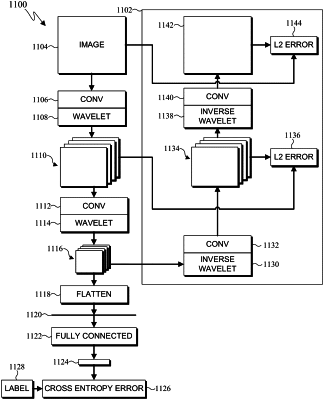| CPC G06N 3/04 (2013.01) [G06N 3/0409 (2013.01); G06N 3/08 (2013.01)] | 20 Claims |

|
1. An electronic device, comprising:
a memory; and
at least one processor coupled to the memory, the at least one processor configured to:
receive input image data to a neural network;
apply a wavelet transform to the input image data at a wavelet layer of the neural network;
generate a plurality of subbands of the input image data as a result of the wavelet transform;
determine a classification prediction using the plurality of subbands;
provide the plurality of subbands to an auxiliary encoder branch of the neural network; and
generate, using the auxiliary encoder branch of the neural network, an output that is separate from the classification prediction and that visually emphasizes one or more features of the input image data that caused the determination of the classification prediction over other features of the input image data;
wherein, to generate the output that visually emphasizes the one or more features of the input image data that caused the determination of the classification prediction over the other features of the input image data, the at least one processor is configured to:
to optimize the neural network, (i) apply a first regularization using a plurality of higher resolution subbands created by the auxiliary encoder branch and at least a portion of the plurality of subbands that correspond to the higher resolution subbands and (ii) apply a second regularization using other image data created by the auxiliary encoder branch and the input image data received by the neural network; and
backpropagate, through the auxiliary encoder branch and after the optimization of the neural network, at least one one-hot vector associated with the classification prediction and a feature for detection to visually emphasize the one or more features of the input image data over the other features of the input image data.
|